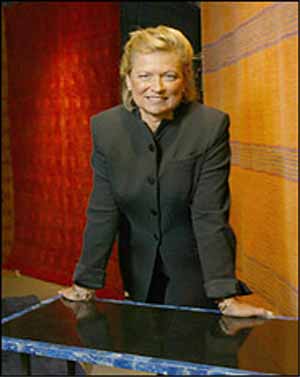
Manhattan rug designer and Fiji RPCV Stephanie Odegard works against child labor
Manhattan rug designer works against child labor
By ZARINE NANDAN
FROM THE PAGES OF NEWS INDIA-TIMES
From the Peace Corps in Fiji to an ultra-elegant showroom in the Design Center at 200 Lexington Avenue in New York City, it has been a long and circuitous journey for Stephanie Odegard. Along the way, there were stops in Jamaica, India and Nepal for this young woman who has parlayed her training as a designer and marketing consultant into a multimillion-dollar business, importing hand-knitted rugs and other traditional handicrafts from India and Nepal.
Well, let me qualify that statement. Odegard does not just import rugs. She designs them, trains the Tibetan craftsmen who weave them to use traditional techniques and makes sure that no child labor is used in their production. All the wool is hand-sorted, hand-spun and hand-carted to her specifications. The result is rugs of such splendid simplicity and elegance that they have been chosen for Bill Gate’s mansion in Seattle, for Daniel — the exclusive new New York restaurant, and, for the homes of many other celebrities.
The directors of the new Richard Meier-designed Getty Museum in Los Angeles were so impressed by her work that they asked her to specially design the rugs for many of the rooms in the museum, in color schemes coordinated with the paintings. Through it all, Odegard remains simple, low-key and unassuming. She loves what she does — perhaps that is why she does it so well. And whatever she does, she does with passion and to perfection.
For instance, when she was in Fiji with the Peace Corps, she was not content with just doing her day job — which was to develop Fijian tapa cloth and other traditional handicrafts for the tourist market. She learned the language, developed a great fondness for Indian food — which she learned to make and generally identified completely with the locals.
It was in Fiji that she began her love affair with India and all things Indian. Years later, when she went to Nepal as a World Bank consultant to help set up the hand-knotted rug industry for the Tibetan refugees, she made a side trip to Varanasi to research the carpet industry there. “Watching the sunrise on the Ganges, I fell hopelessly in love with India,” she told Desi Talk. And the feeling has only intensified since.
Odegard now has various business ventures in India and visits the country often. Her newest project is to link up with French designer Paul Mathieu to start a design workshop in Udaipur, Rajasthan, where the local craftsmen will make pietra dura on marble tables for export to the United States. Pietra dura is a technique of inlaying precious and semiprecious stones in marble.
This old Italian technique, the same that was used to decorate the Taj Mahal, has become practically extinct in that country, and Odegard hopes to revive it by way of India.
Her dream is to renovate a haveli, or small fort, in Rajasthan and turn it into an atelier for designers from all over the world, who will use indigenous skills and sustainable raw material to create handicrafts of exceptional design for sale in the West. It will be a mixture of Eastern and Western influences and perhaps result in a completely new sensibility that will be thoroughly international. The first products of this collaboration could be seen at the French Designer Showhouse in New York, where the marble vaisseau chandelier and sconces as well as the white metal benches were made by Odegard Inc. in India.
On her trips to India, Odegard, who is very interested in Ayurveda, takes advantage of the opportunity to avail of ayurvedic treatments in the south.
“It changes my body completely and makes me a new person,” she said.
Her mind and spirit, however, retain the same tolerant, idealistic and benevolent influences she grew up with in Minnesota. Her greatest pleasure comes from seeing how the lives of the many people she has employed over the years have grown and improved. “The quality of our carpets is linked to the quality of life of the weavers,” she maintained. “Today, the Tibetan weavers earn decent wages and their children go to school to become lawyers and doctors, not bonded laborers, as was the custom.”
This is a direct result of the ‘Rugmark’ campaign, of which Odegard Inc. is a staunch supporter. The Rugmark Foundation is a nonprofit organization, working to end child labor and offer educational opportunities to children of weavers in India, Pakistan and Nepal.
The ‘Rugmark’ label on a carpet ensures that it is not woven using child labor. Its monitors carry out random inspections of carpet looms. Both exporters and importers contribute a portion of the sale price for the rehabilitation and education of child weavers.
Odegard’s social conscience does not end there. She employs many Tibetans, often lectures on Tibetan rug weaving techniques and supports children’s schools in Nepal. She is at the forefront of many good causes and never says no to anything worthwhile. In 1998, she won the Highest Importer Award from the Nepal Central Carpet Industries Association.
The secret of her success is simplicity. “I like simple things,” she declared. Her first customers were architects and designers who were looking for rugs that would not dominate their interiors. “I learned to appreciate beige,” she joked.
Even though she built her business in the ostentatious 1980’s, she always emphasized understated tone-on-tone designs, which, she believes, show off the best qualities of hand-dyed and hand-knotted Himalayan wool. And judging by her success, this is what most of her high-end customers want as well.
